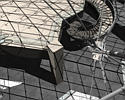|
Sean knew when he started to model the Pei Pyramid at the Louvre
that it might turn out to be
the most complex non-algorithmic model ever created.
It may well be, as it contains about 33 million triangles
when its spline surfaces are tesselated for rendering.
This model serves as a goal for global illumination algorithms.
Can one efficiently calculate an accurate lighting solution
for a scene this complex?
 Clearly, there are too many surfaces in the model
for an algorithm that records the amount of light falling on each surface.
The memory requirements alone make that impossible.
This ray traced image does not include any global interreflections,
and the shadows and reflections are unrealistically crisp.
A Monte Carlo solution would have to run for a very long time,
but might produce a reasonable image.
However, if no global solution can be computed and saved,
everything must be recalculated every time the viewer changes position.
Clearly, there are too many surfaces in the model
for an algorithm that records the amount of light falling on each surface.
The memory requirements alone make that impossible.
This ray traced image does not include any global interreflections,
and the shadows and reflections are unrealistically crisp.
A Monte Carlo solution would have to run for a very long time,
but might produce a reasonable image.
However, if no global solution can be computed and saved,
everything must be recalculated every time the viewer changes position.
 As mentioned, the many triangles of this environment present problems
for recording the light that falls on the environments surfaces.
But they also create extra computation when calculating shadows/shading
on the few large surfaces in the space.
This view to the area below ground level
shows how many shadows the cables and trusses cast on the floor.
This model will serve as a severe test for our algorithms for years to come.
As mentioned, the many triangles of this environment present problems
for recording the light that falls on the environments surfaces.
But they also create extra computation when calculating shadows/shading
on the few large surfaces in the space.
This view to the area below ground level
shows how many shadows the cables and trusses cast on the floor.
This model will serve as a severe test for our algorithms for years to come.
|

